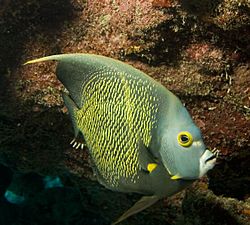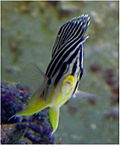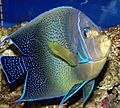Marine angelfish facts for kids
Quick facts for kids Marine angelfish |
|
|---|---|
 |
|
| French angelfish (Pomacanthus paru) | |
| Scientific classification | |
| Kingdom: | |
| Phylum: | |
| Class: | |
| Infraclass: | |
| Superorder: | |
| Order: | |
| Family: |
Pomacanthidae
|
Marine angelfish are a group of beautiful fish that live in the ocean. They are part of the family called Pomacanthidae. You can find them on shallow coral reefs in warm parts of the Atlantic, Indian, and mostly the western Pacific oceans. There are about 86 different kinds of marine angelfish, belonging to seven main groups (genera).
Contents
Amazing Angelfish: What They Look Like
Marine angelfish are some of the most eye-catching fish on the reef. They have bright colors and flat bodies, which are thin from side to side. They look a lot like butterflyfish, which are also colorful reef fish.
You can tell angelfish apart from butterflyfish by looking at their gills. Angelfish have strong, sharp spines near their gill covers. This is actually how they got their family name, Pomacanthidae. It comes from two Greek words: poma, meaning "cover," and akantha, meaning "thorn."
Many angelfish species have long, flowing parts on their dorsal (top) and anal fin (bottom) fins. They have small mouths and fairly large pectoral fins, which are on their sides. Their tail fins can be rounded or shaped like a crescent moon.
The biggest angelfish is the gray angelfish, which can grow up to 60 centimeters (about 2 feet) long. On the other hand, some angelfish from the Centropyge group are very small, not growing more than 15 centimeters (about 6 inches). Most angelfish are usually between 20 to 30 centimeters (8 to 12 inches) long.
Smaller angelfish are popular pets for people who have aquariums. The larger ones are sometimes caught for food. However, it's important to know that eating some marine angelfish can cause ciguatera poisoning, which is a type of food poisoning.
The queen angelfish can grow up to 45 centimeters (about 1.5 feet). It has bright neon blue and yellow scales. It also has shiny purple and orange markings. Even with all these bright colors, it's surprisingly good at hiding and is quite shy.
Angelfish Behavior and What They Eat
Larger angelfish can be quite brave and don't seem to be afraid of divers. Most angelfish adapt well to living in aquariums. However, some are picky eaters and are hard to keep as pets.
What an angelfish eats often depends on its specific group. For example, Genicanthus species eat tiny floating animals called zooplankton. Centropyge angelfish prefer to eat stringy algae. Other angelfish mainly eat creatures that stay in one place on the seafloor. These include sponges, tunicates (sea squirts), bryozoans (moss animals), and hydroids (small sea animals).
On Caribbean coral reefs, angelfish mostly eat sponges. They play an important role in keeping the reef healthy. By eating faster-growing sponge species, they help stop the sponges from covering up the corals that build the reef.
Most marine angelfish live in the shallow parts of the reef. They usually don't go deeper than 50 meters (about 164 feet). However, one species, Centropyge abei, has been found living as deep as 150 meters (about 492 feet).
Angelfish are active during the day, which means they are diurnal animals. At night, they hide in the cracks and spaces of the reef. Some angelfish live alone and form pairs that defend their territory. Others live in groups called harems. In a harem, one male is in charge of several females. When they are young, some angelfish act as cleaner fish, eating parasites off other fish.
Reproduction and Life Cycle
Many angelfish species change their colors a lot when they become adults. For example, young male ornate angelfish, Genicanthus bellus, have wide black stripes and look just like females. But as they grow up, bright orange stripes appear on their sides and back.
These color changes are thought to be linked to their social rank. And it's not just males that change colors. All marine angelfish species are known as protogynous hermaphrodites. This is a fancy way of saying they can change their sex. If the main male in a harem is gone, one of the females will turn into a male and take his place.
Marine angelfish release many tiny, floating eggs into the water. These eggs then become part of the plankton, which are tiny organisms that drift in the ocean. The eggs float freely with the currents until they hatch. Many of these eggs are eaten by other creatures that feed on plankton.
Angelfish Families: A Closer Look
There are 87 known species of marine angelfish, divided into eight main groups (genera):
| Image | Genus | Number of Living Species |
|---|---|---|
 |
Apolemichthys | 8 |
 |
Centropyge | 30+ |
 |
Chaetodontoplus | 13 |
 |
Genicanthus | 10 |
 |
Holacanthus | 8 |
 |
Paracentropyge | 1 |
 |
Pomacanthus | 13 |
 |
Pygoplites | 1 |
Images for kids
See also
 In Spanish: Peces ángel para niños
In Spanish: Peces ángel para niños




